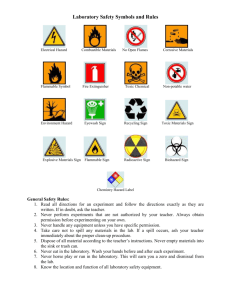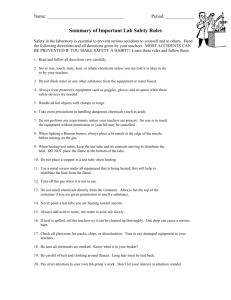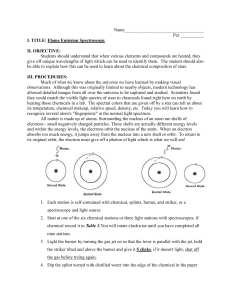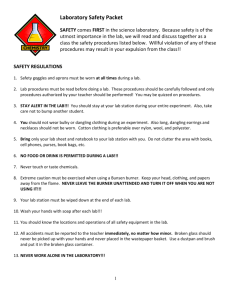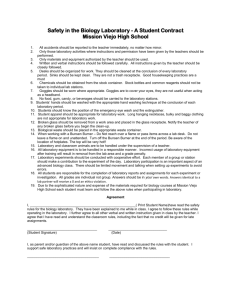Safety Video Notes
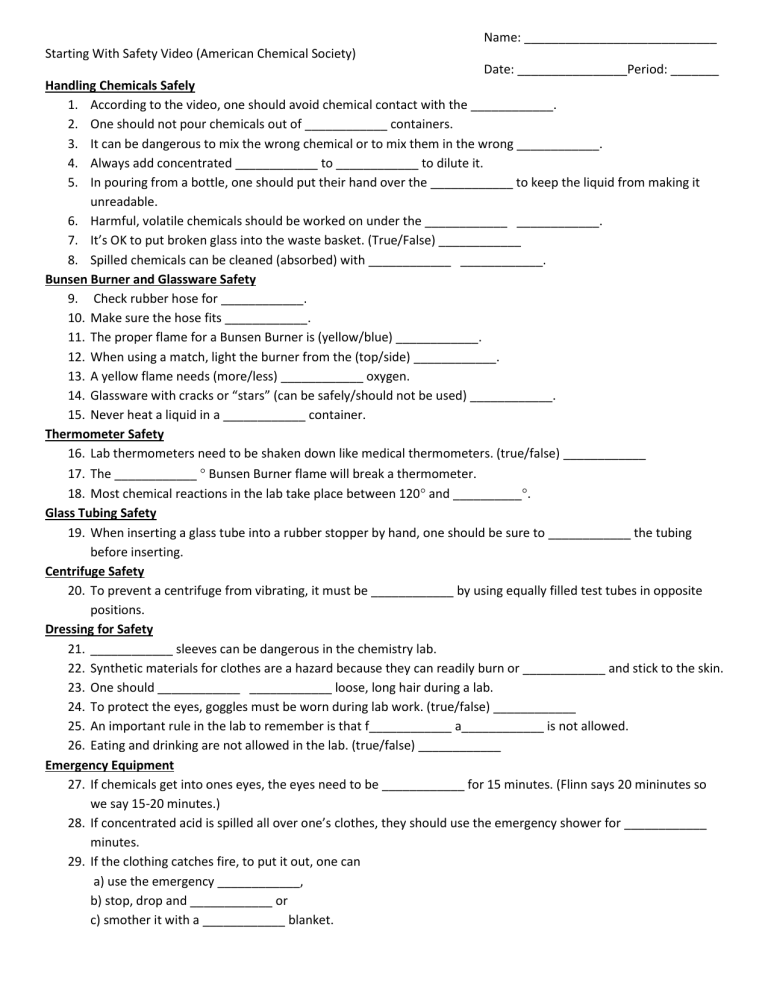
Name: ____________________________
Starting With Safety Video (American Chemical Society)
Date: ________________Period: _______
Handling Chemicals Safely
1.
According to the video, one should avoid chemical contact with the ____________.
2.
One should not pour chemicals out of ____________ containers.
3.
It can be dangerous to mix the wrong chemical or to mix them in the wrong ____________.
4.
Always add concentrated ____________ to ____________ to dilute it.
5.
In pouring from a bottle, one should put their hand over the ____________ to keep the liquid from making it unreadable.
6.
Harmful, volatile chemicals should be worked on under the ____________ ____________.
7.
It’s OK to put broken glass into the waste basket. (True/False) ____________
8.
Spilled chemicals can be cleaned (absorbed) with ____________ ____________.
Bunsen Burner and Glassware Safety
9.
Check rubber hose for ____________.
10.
Make sure the hose fits ____________.
11.
The proper flame for a Bunsen Burner is (yellow/blue) ____________.
12.
When using a match, light the burner from the (top/side) ____________.
13.
A yellow flame needs (more/less) ____________ oxygen.
14.
Glassware with cracks or “stars” (can be safely/should not be used) ____________.
15.
Never heat a liquid in a ____________ container.
Thermometer Safety
16.
Lab thermometers need to be shaken down like medical thermometers. (true/false) ____________
17.
The ____________
Bunsen Burner flame will break a thermometer.
18.
Most chemical reactions in the lab take place between 120
and __________
.
Glass Tubing Safety
19.
When inserting a glass tube into a rubber stopper by hand, one should be sure to ____________ the tubing before inserting.
Centrifuge Safety
20.
To prevent a centrifuge from vibrating, it must be ____________ by using equally filled test tubes in opposite positions.
Dressing for Safety
21.
____________ sleeves can be dangerous in the chemistry lab.
22.
Synthetic materials for clothes are a hazard because they can readily burn or ____________ and stick to the skin.
23.
One should ____________ ____________ loose, long hair during a lab.
24.
To protect the eyes, goggles must be worn during lab work. (true/false) ____________
25.
An important rule in the lab to remember is that f____________ a____________ is not allowed.
26.
Eating and drinking are not allowed in the lab. (true/false) ____________
Emergency Equipment
27.
If chemicals get into ones eyes, the eyes need to be ____________ for 15 minutes. (Flinn says 20 mininutes so we say 15-20 minutes.)
28.
If concentrated acid is spilled all over one’s clothes, they should use the emergency shower for ____________ minutes.
29.
If the clothing catches fire, to put it out, one can
a) use the emergency ____________, b) stop, drop and ____________ or c) smother it with a ____________ blanket.
Starting With Safety Video (American Chemical Society)
Answer Key
Handling Chemicals Safely
1.
According to the video, one should avoid chemical contact with the skin .
2.
One should not pour chemicals out of unmarked containers.
3.
It can be dangerous to mix the wrong chemical or to mix them in the wrong order .
4.
Always add concentrated acid to water to dilute it.
5.
In pouring from a bottle, one should put their hand over the label to keep the liquid from making it unreadable.
6.
Harmful, volatile chemicals should be worked on under the fume hood .
7.
It’s OK to put broken glass into the waste basket. (True/False) false
8.
Spilled chemicals can be cleaned (absorbed) with kitty litter .
Bunsen Burner and Glassware Safety
9.
Check rubber hose for cracks .
10.
Make sure the hose fits securely .
11.
The proper flame for a Bunsen Burner is (yellow/blue) blue .
12.
When using a match, light the burner from the (top/side) side .
13.
A yellow flame needs (more/less) less oxygen.
14.
Glassware with cracks or “stars” (can be safely/should not be used) should not be used .
15.
Never heat a liquid in a closed container.
Thermometer Safety
16.
Lab thermometers need to be shaken down like medical thermometers. (true/false) false
17.
The 600
Bunsen Burner flame will break a thermometer.
18.
Most chemical reactions in the lab take place between 120
and -20
.
Glass Tubing Safety
19.
When inserting a glass tube into a rubber stopper by hand, one should be sure to lubricate the tubing before inserting.
Centrifuge Safety
20.
To prevent a centrifuge from vibrating, it must be balanced by using equally filled test tubes in opposite positions.
Dressing for Safety
21.
Baggy long sleeves can be dangerous in the chemistry lab.
22.
Synthetic materials for clothes are a hazard because they can readily burn or melt and stick to the skin.
23.
One should tie back loose, long hair during a lab.
24.
To protect the eyes, goggles must be worn during lab work. (true/false) true
25.
An important rule in the lab to remember is that f ooling a round is not allowed.
26.
Eating and drinking are not allowed in the lab. (true/false) true
Emergency Equipment
27.
If chemicals get into ones eyes, the eyes need to be washed for 15 minutes.
28.
If concentrated acid is spilled all over one’s clothes, they should use the emergency shower for 15 minutes.
29.
If the clothing catches fire, to put it out, one can a) use the emergency shower , b) stop, drop and roll or c) smother it with a fire blanket.

